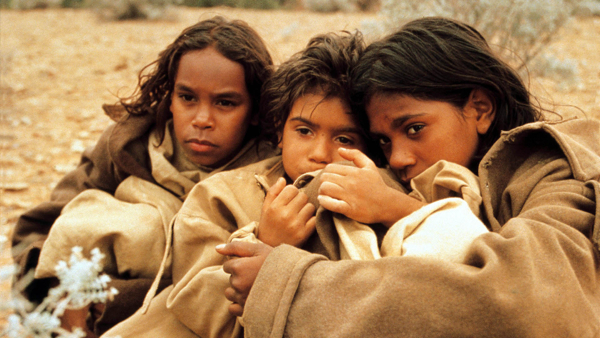Movie review by Greg Carlson
Australian director Phillip Noyce, the helmer behind such wastes of time as “Sliver,” “The Saint,” and “The Bone Collector,” has practically erased the bad memories of his recent Hollywood sludge with the masterstroke of making two prestige art films in a single year. Along with an updating of Graham Greene’s “The Quiet American,” Noyce has directed “Rabbit-Proof Fence,” an emotionally wrenching historical drama that turns its mostly unflinching gaze on the Australian government’s disgusting, decades-long policy of removing “half-caste” Aboriginal children from their mothers in the name of “saving them from themselves.”
Set in 1931, “Rabbit-Proof Fence” uses its titular symbol – the series of transcontinental dividers designed to protect farm crops from voracious rabbits – as a reflection of the centuries-long cultural clash between white European “settlers” and the country’s indigenous population. To this day, the Australian government struggles with the nasty shadows of eugenics, racism, and even genocide, but seventy years ago, administrators like A.O. Neville (played in the film by Kenneth Branagh) crowed about the benefits of “breeding” the unenlightened blood out of the “primitive” population in order to give the Aboriginal people opportunities in society (read: jobs as servants and laborers).
The idea of forcibly taking children away from their mothers is nightmarish, and the scenes of Molly (age 14), Gracie (age 10), and Daisy (age 8) – two sisters and a cousin – being hauled off to a government-run school/boarding house/slave camp will turn the stomach of all but the most hardened misanthrope. Molly (Everlyn Sampi), Gracie (Laura Monaghan), and Daisy (Tianna Sansbury) are all played by non-actors, and Noyce’s results with the trio are consistently impressive. While Branagh is saddled with the thankless task of bringing to life a misguided and ignorant antagonist, Noyce thankfully spends most of the film’s time with the three little girls, observing many of the awesome details of their odyssey.
It takes Molly only one day at the government dormitory to figure out that she needs to leave. Taking Daisy and Gracie with her, she sneaks away under cover of heavy rain (so as to frustrate the efforts of preternaturally gifted tracker Moodoo, played by David Gulpilil, from the outback classic “Walkabout”), and begins a journey of some 1200 miles, in order to be reunited with her mother. The arduous trek, which the girls made entirely on foot, took them more than two months, and the entire quest was fraught with the triple threat of eluding recapture by government trackers, finding enough food to sustain them, and avoiding detection by farmers who might potentially contact Neville’s office.
Shot by ace cinematographer Christopher Doyle, “Rabbit-Proof Fence” tempers the girls’ unrelenting endurance and determination with the otherworldly beauty of the stark and haunting Australian landscape. It is uncertain how many details of the girls’ flight were concocted specifically for the film (Christine Olsen’s screenplay was based on an account by Molly’s daughter Doris Pilkington), but the essential facts remain stunning regardless of dramatic flourish. Seeing footage of the real, 85-year-old Molly and the 79-year-old Daisy, who appear at the conclusion of the film, is a powerful exclamation point to all that has come before, but hearing Molly tell what happened to them after their 1931 adventure is a genuinely tragic, thoroughly astonishing coda.
